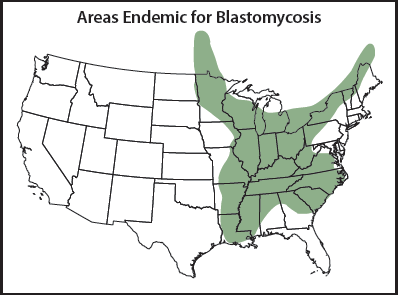There is a fungus among us! We are exposed to fungal spores
daily, and so are our pets. Over the next few weeks, I thought we’d take a look
at the various types of fungal organisms we may encounter. Some are merely
annoying while others can be quite serious.
Blastomycosis is one of the more serious fungal infections.
This particular fungus is primarily located in Missouri ,
Tennessee , Ohio
and along the Mississippi River .
It prefers to grow in areas with wet soil. Once inhaled, it can spread to
various parts of the body. While it can affect any animal, dogs seem to be the
most severely and most frequently affected. It cannot be transmitted to other
animals or people, but if these animals were exposed to the same environment
they could contract this organism as well.
General symptoms are vague and include loss of appetite,
decreased energy and a significantly elevated temperature. Symptoms will vary
depending on where the organisms start to grow in the body. Some of the more
commonly affected organs include the eyes, lungs, bones and skin. The eyes will
typically become very irritated, sometimes with swelling and discharge. Coughing
is typically seen when the lungs are affected. If x-rays of the lungs are taken
it is often referred to as a ‘snow storm’ affected because it is difficult to
discern normal structures. With joints typically there will be limping and
extreme pain. In severe cases it can even cause fractures of the bones. Skin
lesions typically will develop draining tracts that will not respond to
antibiotics and have a very thick discharge.
 |
| Snow Storm appearance to lungs. (Image Source) |
There are treatment options, however depending on the
severity of the condition treatment is not always successful. Long term use (sometimes
months) of anti-fungal medications are often required to alleviate the
symptoms. It is also important to maintain a healthy immune system. This means
a good balanced diet, and avoiding medications (such as steroids) that could
inhibit the immune system. In some severe ocular (eye) cases it is necessary to
remove the eye to keep the patient comfortable.
 |
| Cytology identifying blastomycosis. (Image Source) |
There are a variety of tests that can be done to detect the
fungal spores in the body. These include biopsies, sometimes cytology (looking
at the cells under a microscope), blood tests or even urine tests. With this
being such a serious condition though, sometimes treatment will be started
before test results are available. The sooner treatment is initiated the more
likely for a better outcome. For more information on Blastomycosis please click
here.


No comments:
Post a Comment